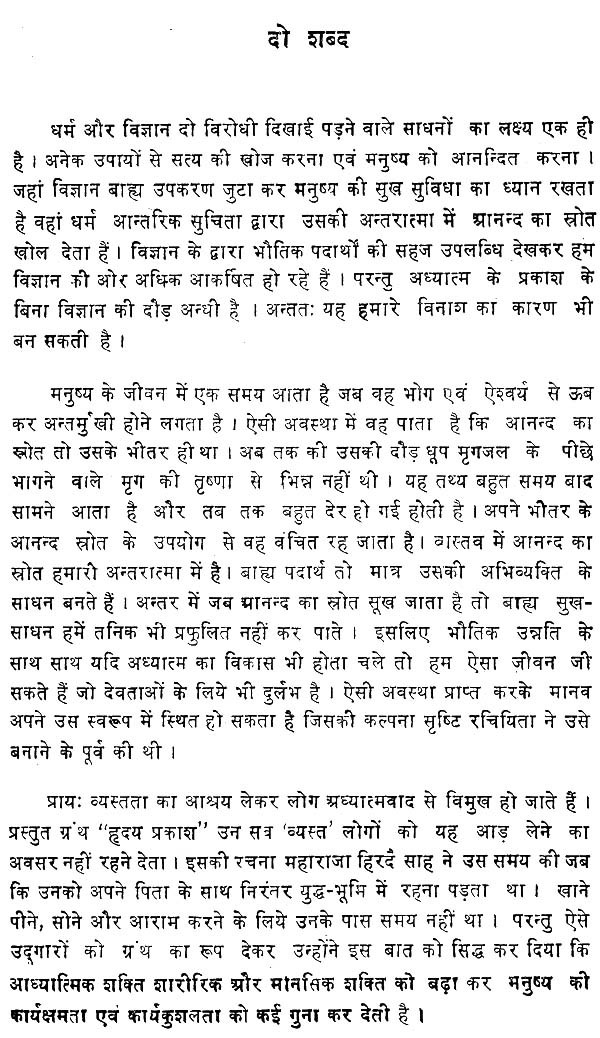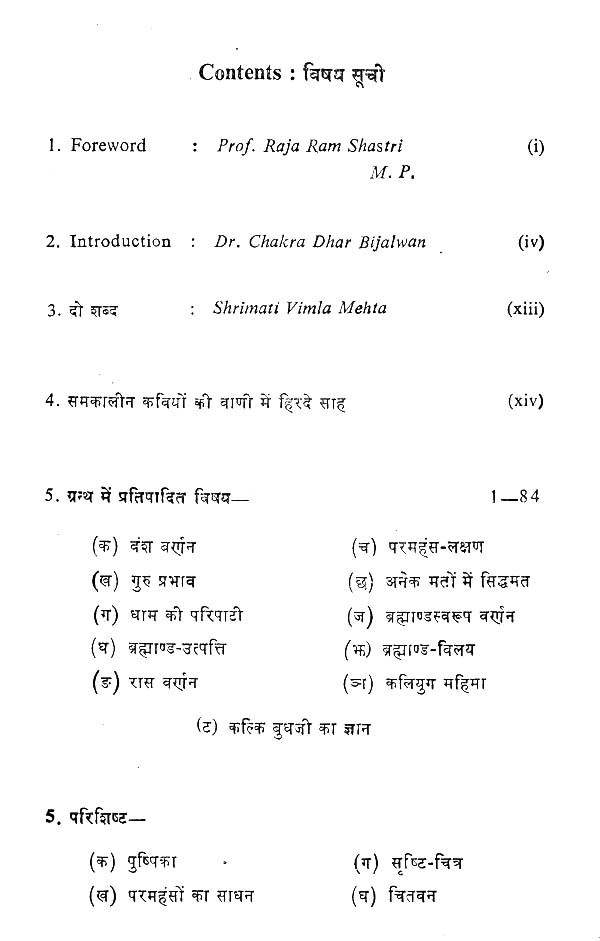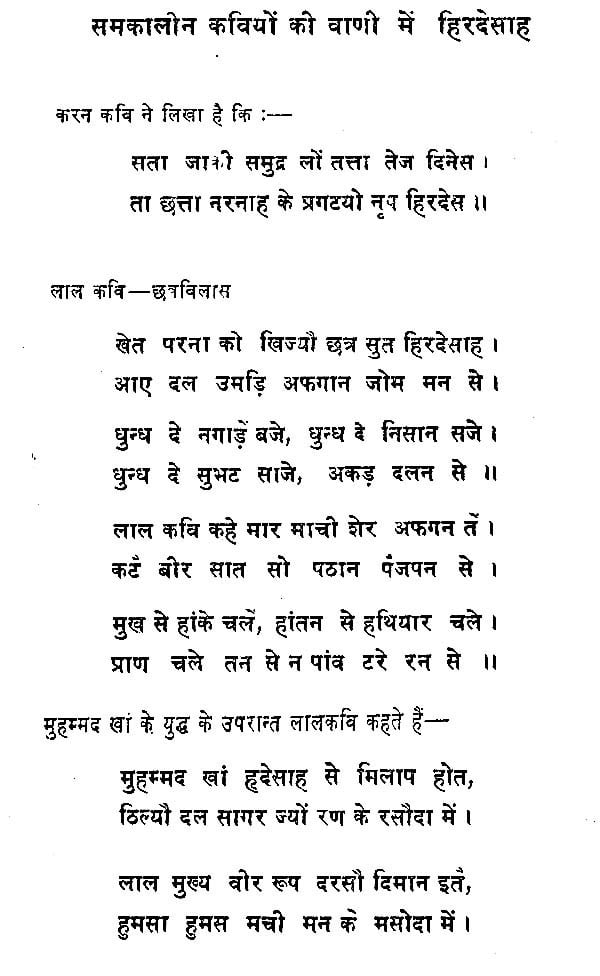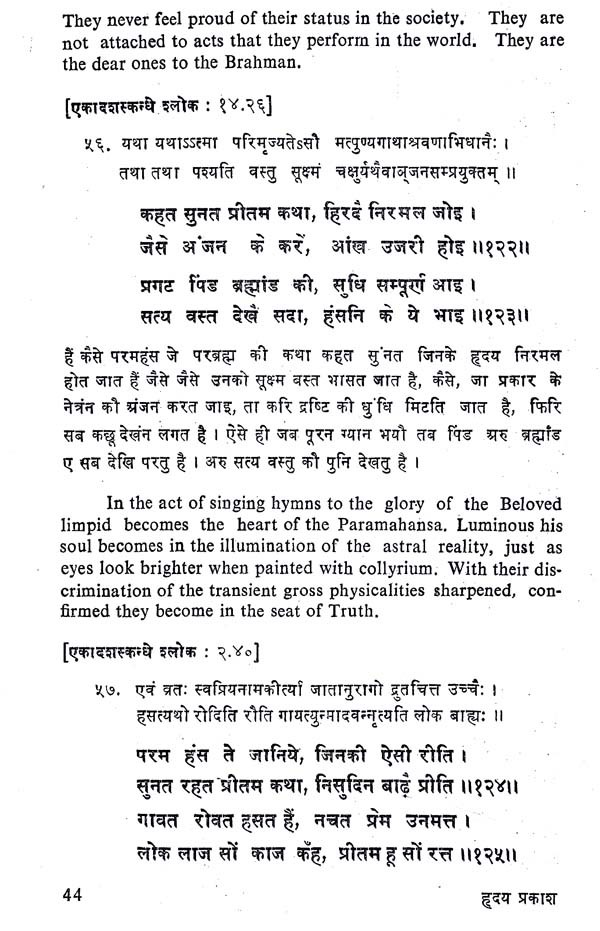
Hridaya Prakash of Hirde Sah
Book Specification
| Item Code: | AZE278 |
| Author: | C.D. Bijalwan and R.D. Jha |
| Publisher: | SHRI PRANNATH MISSION, DELHI |
| Language: | SANSKRIT, HINDI AND ENGLISH TRANSLATION |
| Edition: | 1976 |
| Pages: | 126 |
| Cover: | PAPERBACK |
| Other Details | 8.50x5.50 inches |
| Weight | 150 gm |
Book Description
The absolute Brahma contains the whole creation and limitless time in His timeless and space-less Being, which transcends time and space. This absolute reality which is both immanent and transcendental at the same time is difficult to grasp for mortals like us because in creation there is time and sequence and manifoldness, while the absolute contains all time and all differences in one eternal moment. This time lessness containing all teniporal sequence is difficult to grasp because we work throughout our lives in time, and every event of our life has some sequence. In fact, it is from this time bound point of view that the absolute reality also has to be grasped in 'Taratamya', that is, a hierarchy and sequence. The Parabrahma thus becomes the Aksaratita, the Aksara and the Ksara Brahma. The Akṣaratita is the Purna Brahma. It contains and is composed of two aspects, the conscious reality that is Aksara Brahma and Shyamă the eternal Bliss of having absorbed and transcended the limitless variety of creation. But in order to absorb manifoldness, it has first to be created. Our mind, conditioned as it is by temporal sequence, cannot grasp evolution and dissolution in one act of consciousness. Hence we conceive Srsti as first having been created, and then absolved back in to the prime consciousness. Here the Akṣarätita, the conscious reality becomes Aksara the creator and yogmaya becomes his creative power which creates the grand illusion of limitless creation for Aksara Brahma to ex perience the joys of creation and for Shyama to experience the sorrows of incompleteness and separation before it is negated. and regains its eternal communion with Brahma.
This creation of Yogmaya in totality and essence, is Ksara Brahma who in turn creates the whole Brahmananda. Now in the Srsti stage, when the one Brahma becomes many individual souls, there is always an unconscious hankering in them for re-union with Brahma, because that is their real nature. Multiplicity and otherness is just an illusion to enable them to experience, first the joy of creation and variety and then the agony of separation from their pristine nature. Once they have gone through this experience, they are irresistably drawn back to their original state in which there is perfect communion and identity with Brahma in Paramadhama. The joy of this communion after having experienced the Sansara is conceived as the bliss of Rasalila, that is eternal play of the Atma with the Paramatma or of Shyama and her maidens, the Paramhansas or Brahmamunis, with Brahma Himself.
In the treasure trove of classical Indian literature there is no dearth of poetic works on the devotional aspect of spiri tualism. Starting from the earliest scriptures like the Vedas and the Puranas, numerous works with devotional themes make a string of literary pearls. There is Shrimad Bhagawata, re nowned for its broad canvas and intricate pattern. There are critical treatises like Shandilya Sutra and Närada Bhaktisutra probing at all levels of intellectual concern, the concept of devotion and the way of liberation. One of the four major periods of Hindi literature consists entirely of devotional works and is appropriately called as Bhaktikal. Some of the pillars of this period namely Tulsidas, Surdas, Kabir and Mira-have become household names in every Hindu family.
Stretched over thousands of years and drawing upon the genius of different parts of India, the broad stream of this literary genre embraced numerous tributaries and branched off in many new directions. However, for the sake of analysis and better understanding of this trend, the devotional poetry has been conveniently categorized in two major branches known as Saguna and the Nirguna. Among the luminaries of the for mer are such popular names like Ballabhācārya, Mīrā. Narsi Mehta, Surdās and Nanddas-all ardent devotees of Lord Krishna. And while Kabir is the most vocal propounder of the knowledge-based (Jnana Märga) Nirguna Cult, Jayasi is regarded as the chief spokesman of Nirguna with emphasis on divine love.












